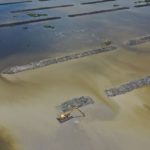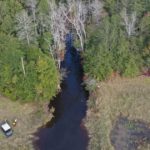Wetlands are important for our environment. They support a variety of plant and animal life—including endangered species—and there are several kinds of migratory birds that live there at different times of the year.
Wetlands are important because they have a lot of environmental advantages, like improving water quality and helping to control flooding by absorbing water. They’re protected by federal, state, and local laws. These laws are enforced by the US Army Corps of Engineers (USACE).
If you need to alter, damage, or remove any wetland area for your construction or conversion project, you’ll need to do a wetland delineation first.
Wetland delineations are common procedures done to figure out if a piece of land is a wetland. Despite what you might’ve heard, wetlands aren’t always swamps, bogs, or marshes. In fact, most of the time it’s hard to tell.
The delineation process not only determines if there is a wetland, but also how big the wetland area is. It tells you exactly where the wetland area falls inside your project plan, so you can make sure you’re in compliance with the Clean Water Act.
 via Pixabay
via Pixabay
When Should I Get a Wetland Delineation?
If you’re a landowner or developer who wants to build on or convert a wetland—which includes filling a wetland, pond, shoreline, or stream—will need a wetland delineation. To avoid having to put off the project any more than necessary, you should start the wetland delineation process as soon as possible.
This way, by the time you’re ready to start building, your delineation and permits will be ready to go. The last thing you want is to start your project and have to pause it because you haven’t finished the delineation process yet.
If you’ve hired a consulting firm to complete a wetland delineation on your property and they’ve completed the process and given you a permit, you’re free to build on that site. If the agency believes there is a regulated wetland on your site, you’ll have to comply with the laws of section 404 under the Clean Water Act, which can either restrict or stop your project.
The entire wetland delineation process can be expensive, but it really depends on the scale of your project. For a wetland delineation that covers less than 5 acres, it would cost you anywhere from $4,000 to $5,000. But for larger developments, you could be looking at spending between $15,000 and $20,000—not counting the cost of the actual construction.
It might be worth exploring how much you could save by choosing a site on dry land. Wetland areas in general need more maintenance before, during, and after construction is finished. So, not only is there a lot to learn about the wetland delineation process, but there’s also a lot to pay for.
So, make sure to check into all your options to see whether building in a wetland area is really worth the cost and effort it would take.
How are Wetland Delineations Completed?
First, you’ll have to get in touch with wetlands consulting company, one that is familiar with the 1987 Corps of Engineers Wetlands Delineation Manual and the corresponding Regional Supplement. This manual is the authority on the delineation and permit process, so if you want to build on a wetland, it would be a good idea to learn all you can about it.
Before you set up an appointment with the agency, you should ask a lot of questions to make sure you find the consultant who’s going to be right for you. Make sure the consultants have experience with the Corps of Engineers Wetlands Delineation Manual and know which resources to use to find any existing information (including wetland info) about your property.
Wetland delineations are done to make sure that wetlands are being protected as much as possible. The Environmental Protection Agency (EPA) released a paper called the Wetland Regulatory Authority, which details the guidelines they follow to protect wetlands.
The delineation process follows the Wetland Delineation Manual that we mentioned earlier. Every region will most likely have its own requirements that fit with the Department of Natural Resources’ (DNR) regulations in that area, so make sure to check the local regulations in your area as part of the application process.
Areas that have the potential to be wetlands are investigated first by analyzing aerial photographs and maps before a hands-on investigation is done, during which soil samples are taken and on-site surveys are completed.
The distinction between wetlands and uplands is based on the results of visual inspections as well as the soil samples. The Natural Resource Conservation Service (NRCE) examines vegetation and soil.
If the vegetation is classed as hydrophytic (grows at least partially submerged in water) and the soil classed as hydric (exhibits wet conditions), the area will most likely be determined as a wetland.
The final wetland delineation report should have the following:
- Delineation methods
- Results
- Data forms
- Findings documented clearly
- Pictures
- Climate conditions
- Any other relevant information you’d like to include
There are three different categories your land could fit into:
- No wetlands found—no wetlands exist on the site you’re going to build on, so construction can continue as normal.
- Isolated wetlands—wetlands are in the area but aren’t considered under USACE jurisdiction.
- Regulated wetlands—the wetlands on your land are under the jurisdiction of the US Army Corps of Engineers (USACE) and have to follow their guidelines.
If your wetland is classified as an isolated wetland, it just means that your wetland isn’t connected to any other waters so your area is exempt from jurisdiction and you can build whatever you’d like. Wet farmlands used for crop growth also fit into this category.
Regulated wetlands are subject to USACE jurisdiction, which means you’ll have to closely follow section 404 of the Clean Water Act. The USACE is the organization that enforces these regulations.
To help your permit application get approved, you could even consider wetland mitigation. By including a wetland mitigation plan as part of your application, you’re showing that you’re agreeing to build new wetlands somewhere else that are equal to or larger than the wetland that will be impacted by your construction project.
Wetland mitigation can be done in one of three ways, including making man-made wetlands to compensate for losing the original area, improving the condition of the original wetlands by raising or filling certain areas, or restoring the area so its historical and environmental impact isn’t threatened.
Wetland mitigation is one way of making sure that your construction project is environmentally friendly, while also boosting your chances of getting a permit. Depending on how much wetland will be impacted by your project, the USACE and the EPA will decide whether to provide you with a permit to build.
Even if you’ve gotten basic approval from the USACE and the EPA, you might also have to get permission from local agencies before you start building on wetland areas. It’s important to check the wetland regulations in your area before you apply for a permit so you don’t end up wasting your time or money.
 via Pixabay
via Pixabay
How Long Will It Take to Perform a Wetland Delineation?
The length of time it takes to do a wetland delineation depends on the size of your area. It can take 1-2 days to investigate your area using maps, aerial pictures, and on-site examination, and then another 1-2 days to gather soil samples and other necessary data in your area.
The final reports can take another 2-4 weeks to complete after the investigation process is done, and you might not get the reports for months after that. So, if you know you’re going to need a wetland delineation in your area, get it done as soon as possible so you can start your project.
How Long Does a Wetland Delineation Permit Last?
After you’re approved, a wetland delineation permit is valid for 5 years. If you think your project will take longer than this, then you’ll need to look into asking for an extension.
If you don’t ask to extend your wetland delineation permit, your permit will expire, and you’ll have to stop your construction project until another wetland delineation is completed. You’ll have to go through the whole process over again, including getting another permit.
What Happens If I Don’t Get a Wetland Delineation?
If you don’t agree with the decision made by the consulting firm, or if you’re flat-out denied a permit to build, you can appeal the decision that was approved by the USACE or the EPA and take it to court.
There are always risks that come with building near or on a wetland, and construction companies could choose to refuse to work with you. Having a permit could make those companies feel a little more comfortable taking on your project.
Wetlands are notoriously hard to build on because the wet terrain can cause a lot of issues. The wet conditions mean that equipment isn’t as secure, property foundations aren’t as stable, and it’s harder for laborers to work on soggy ground.
All this—combined with the environmental and ecological impacts your construction plan might come with— might make you wonder whether it’s worth building on wetlands at all. Take a look at Fenstermaker’s environmental service page to get a better idea.
So, if your wetland delineation doesn’t end up with you getting a permit, you can appeal it. But if there’s an alternative to building on a wetland, it might be a good idea to at least consider it. You might just save yourself time, money, and hassle by choosing to build elsewhere.
 via Pixabay
via Pixabay
Final Thoughts
Wetlands are fantastic spots for wildlife watching, data collection, or simply enjoying nature, but they can be difficult to live in. If you’re looking to build a personal property in a wetland area, make sure you research how the terrain could affect your life there.
Living on wetlands could come with some struggles, especially if the area gets frequent rainfall. You have to consider that water maintenance might be a major issue for you, especially as climate change continues to cause an increase in the levels of water in these areas.
Although the wetland delineation process might be a tad stressful and time-consuming for you, it’s an important process that keeps the environmental and ecological benefits of wetlands going strong. As protected areas, it’s vital that we allow wetlands to flourish as natural habitats.





